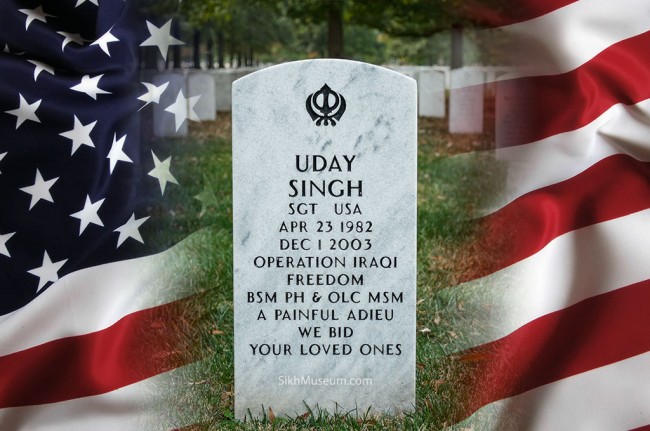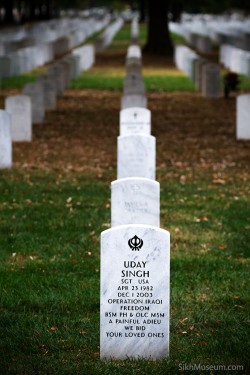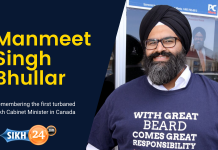


It has been ten years now since a brave Sikh soldier in the US Army was killed in combat in Iraq. I’ve been meaning to visit the military grave of Sargent Uday Singh for a few years now. He was the first Sikh-American soldier whose sacrifice would be honored by a memorial at the Arlington National Cemetery in Washington D.C.
Most Sikhs have never seen the grave of a Sikh soldier, as we usually cremate our dead and scatter the ashes in a body of water. Ironically I’ve had quite a bit of experience with Sikh military graves. Six years ago I acquired the military medal of Pvt. Buckam Singh, one of only nine Sikh soldiers allowed to serve in the Canadian military in World War I. My research uncovered his remarkable story from the fields of Punjab to the battlefields of France nearly a century ago. Pvt. Buckam Singh’s military grave had remained forgotten for nearly a century until I came across it during my research. It is the only military grave in Canada of a Sikh soldier from the World Wars. I created an online exhibit at SikhMuseum.com about Pvt. Buckam Singh and organized a Sikh Remembrance Day Ceremony at his grave that is held every year and attended by the Canadian military and members of the public.
As a Sikh, a historian and a photographer, my planned visit to Uday Singh’s grave in Arlington National Cemetery had a number of objectives. The Sikh in me wanted to pay my respects at his grave. The historian wanted to document Uday Singh’s grave and ensure that his heroic story of military service and sacrifice is not forgotten with the passage of time. The photographer and artist in me wanted to convey my thoughts and experiences visually.
The last time I had been to Arlington National Cemetery had been decades ago as a teenager visiting the city with my family. Arlington is on the tourist trail of must see sites, tourists make the trip there in large numbers primarily to visit President Kennedy’s grave and the eternal flame that burns there. But Arlington is much more than a tourist site, it is also an active military cemetery. For a soldier to be buried at Arlington, it is considered the highest military honour.
The cemetery is a time machine of America’s military past, with graves of Civil War soldiers all the way up to soldiers killed in Iraq and Afghanistan. Among the many war heroes, generals and presidents buried at Arlington National Cemetery, there is one grave that is different from all the others. Uday Singh’s grave is the only one with a Khanda on it, the emblem of the Sikh religion.
Arlington apparently has very strict guidelines about what religious symbols are allowed on grave stones and initially the military bureaucracy did not recognize the Sikh Khanda as an authorized religious symbol. Uday Singh’s family and friends had to struggle with the authorities for nearly six months after his burial before the military finally recognized the legitimacy of the Sikh Khanda and added it to Uday’s gravestone. Ironically during that process Uday’s family had requested a letter from the SGPC in Amritsar to the United States military explaining that the Khanda was a religious emblem of the Sikhs, but the SGPC never even bothered to accommodate the family’s request. It was a local Gurdwara that eventually had to supply the letter to the military. Lesson to be learned: we in the diaspora have to solve our own problems locally and not rely on people in distant India who lack the commitment, resources, skills and the understanding on our needs.
As I prepared for my visit to Arlington, I download a Google App that Arlington Cemetery had developed. By entering in Uday Singh’s name into the app, I was able to see exactly where his gravestone was in the cemetery and how to get there. Uday Singh was buried in Section 60 of the cemetery where soldiers from the Iraq and Afghanistan wars are buried. He was the 44th soldier to be honored in Arlington that had been killed in Iraq.
With a heavy heart and lots of emotions I set out with my camera to visit Uday Singh on a warm fall day in Washington D.C. I had arrived in the city just as the US government shutdown had started due to the impasse between the Republicans and Democrats in the Congress and Senate. Most government run facilities had been shut down, even the Lincoln Memorial. Fortunately someone in the government had the common sense not to shut Arlington down, surprising given how rare common sense is these days on Capital Hill.







 As I arrived I saw large numbers of tourists as well as some uniformed soldiers in the visitor’s center. While almost all of the civilians headed one way (towards President Kennedy’s grave), I headed in another direction, towards Section 60. After a very long walk and passing thousands of graves I finally arrived at my destination. It was very easy to find Uday Singh’s grave among the never ending rows of white marble gravestones. Just like the Nishan Sahib banner can be seen far away indicating a Gurdwara, there was that unmistakable solitary Khanda on white marble drawing me in like a magnet.
As I arrived I saw large numbers of tourists as well as some uniformed soldiers in the visitor’s center. While almost all of the civilians headed one way (towards President Kennedy’s grave), I headed in another direction, towards Section 60. After a very long walk and passing thousands of graves I finally arrived at my destination. It was very easy to find Uday Singh’s grave among the never ending rows of white marble gravestones. Just like the Nishan Sahib banner can be seen far away indicating a Gurdwara, there was that unmistakable solitary Khanda on white marble drawing me in like a magnet.
Joining my hands together I said the Ardas prayer at Uday Singh’s grave then sat down on the grass as a tidal wave of emotions hit me. I have no family ties to Uday, never met him or anyone that knew him, but just being there in that space and time, alone with Uday Singh was overwhelming. Just a 21 year old kid cut down in the prime of his life while on a patrol mission in Iraq, a life that could have been so much more, never will be.
I spent an hour at his grave. During that time I saw a number of families and individuals visiting graves of their loved ones in Section 60. Rows upon rows of other young kids like Uday killed in faraway Afghanistan and Iraq, now just memories and a gravestone in Arlington. I wondered what those families thought of me in Section 60? With my turban and beard, did they think that I was responsible for the death of their son or? Did they know that I was a Sikh, or did that even matter? What was that old man beside a grave behind me thinking as he looked at me? What was that young couple walking by me to get to a grave further down thinking of me? What were those soldiers that walked by thinking? I’ll never know the answers to those questions and perhaps I don’t want to know. Maybe the answers to those questions are a casualty of war itself, the loss of innocence and tolerance in society.
As I was preparing to leave and was walking away from Uday Singh’s grave, I came across a grave of another American soldier killed in Iraq. There were flowers beside his grave and taped on the back of his grave was a faded photograph of his sister hugging him in happier times. On the front of the grave was the familiar star and crescent moon emblem of Islam and the soldiers name was Khan. Further validation that a soldier’s patriotism, courage and sacrifice for his country does not have religious boundaries.
Uday Singh is in good company now as he lies with his fellow soldiers of various nationalities and religions at Arlington National Cemetery. They all paid the ultimate sacrifice for the country they loved, may they rest in peace and never be forgotten.



View more photos of Sgt. Uday Singh’s gravestone
Sandeep Singh Brar is the Curator of SikhMuseum.com and the creator of the world’s first Sikh website, Sikhs.org.





Wow…what an experience,Bhutani ji for u. We hope to visit Uday Singh in the. Spring.
Guru Fateh!
Manmohan Singh Luthra MD